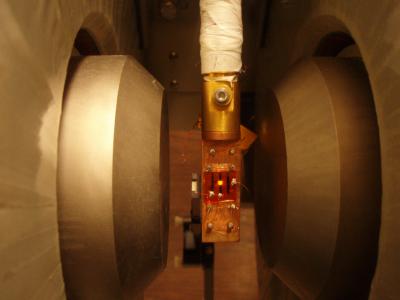Physicists at the University of Utah have invented a new"spintronic"OLED(organic light-emitting diode)that promises to be more eco-friendly,bright and cost-effective than other existing popular LEDs.
 A new"spintronic"organic light-emitting diode glows orangish(center)when the device,chilled well below freezing,is exposed to a magnetic field from the two poles of an electromagnet
A new"spintronic"organic light-emitting diode glows orangish(center)when the device,chilled well below freezing,is exposed to a magnetic field from the two poles of an electromagnet
In the journal Science's issue dated July 13,2012,the study's senior author,Z.Valy Vardeny of University of Utah said that this technology is totally novel.The new organic LEDs will provide improved illumination than normal organic LEDs.
The Utah physicists created a prototype of the new type of LED technically known as a spin OLED or spin-polarized organic LED,capable of emitting an orange color.Further improvements will give rise to red and blue color emissions as well,ultimately resulting in white spin OLEDs.At present,LEDs work at-280 F,and must be developed to operate at room temperature.Along with Tho D.Nguyen,Vardeny developed a new kind of LED.
Utah physicists invented a novel type of OLED that utilizes an organic semiconductor.This"spintronic"device stores useful information utilizing the"spins"of the electrons.
An"organic spin valve"device led to the discovery of new spin OLED.The original spin-valve device that used to regulate electrical current flow can be modified to emit light,turning it to be a spin OLED.
Organic spin valves include three layers,where two metal electrodes(ferromagnets)house an organic layer that functions as a semiconductor in the centre.One of the ferromagnet metal electrodes within the new spin OLED is made up of cobalt,while the other is made up of lanthanum strontium manganese oxide.The new OLED's organic layer includes deuterated-DOO-PPV,an orange-colored light generating semiconductor polymer.The whole device measures 300μin width and length and 40 nm in thickness.
A low voltage is used for injecting electrons that are negatively charged.By applying a magnetic field to the electrodes,the alignment of the spins of the electrons and electron holes can be achieved either parallely or antiparallely.
The new study shows advances in the materials utilized to develop"bipolar"organic spin valves through which new spin OLED can produce light.The first advance is the use of deuterium replacing normal hydrogen in the spin value's organic layer.The second advance is the use of an extremely thin layer of lithium fluoride being deposited on the cobalt electrode,facilitating the injection of negatively charged electrons via one side of the spin valve and positively charged electron holes via the opposite side concurrently,thus making the spin valve"bipolar".
Generation of light can be achieved by injecting electrons and holes simultaneously.Integration of electron with a hole leads to cancelling out and energy is released in the form of light.





